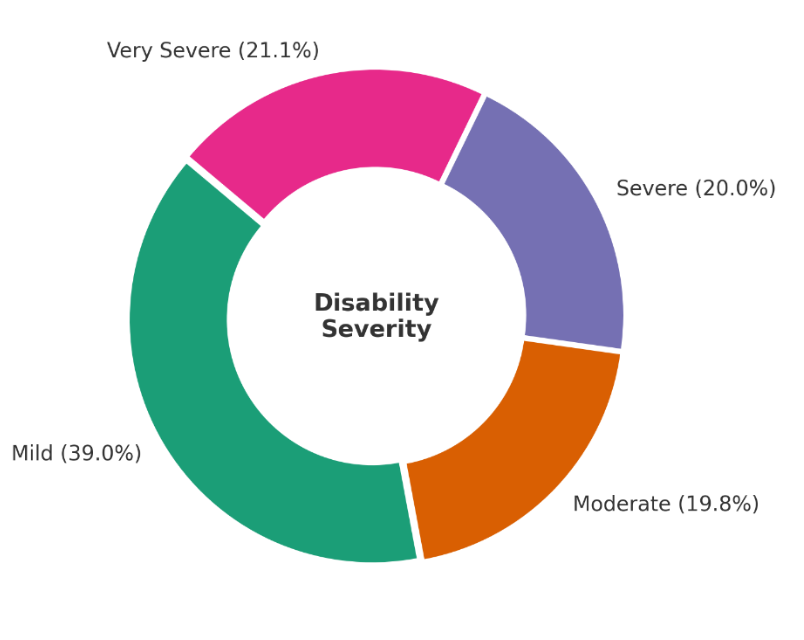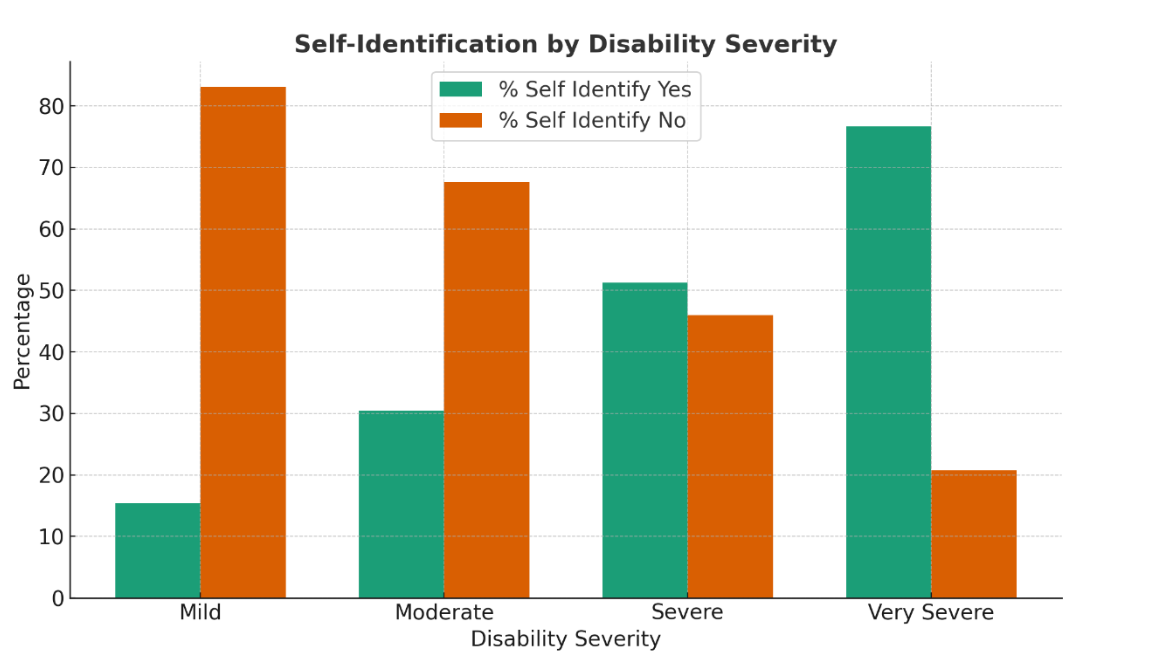In 2023 Statistics Canada released results from the 2022 Canadian Survey on Disability (CSD).3 This survey provided updated information on disability demographics in Canada, including disability frequency by type, segmenting by categories including age, gender, geography, and disability severity. The attention-grabbing number was the overall disability rate: 27% for those aged 15+, a 5% increase since the 2017 survey. This increase was due primarily to increasing frequencies of mental health disabilities in younger age cohorts.
The CSD has been used to justify evolving accessibility standards and policy advocacy in Canada. It has also been used to create baselines of disability frequency by age and gender cohorts globally, including in our own Global Economics of Disability Report4.
Despite the utility of the CSD – which is high – it is easy for organizations to misinterpret its findings, leading to suboptimal forays into disability markets. Chief among these is conflating how the CSD assesses disability, and the extent to which this maps to the way potential customers or employees see themselves.
At its core, the CSD seeks to understand functional occurrences of disability – the frequency and extent to which individuals encounter barriers due to impairments. For this reason, the screening criteria for disability is not one of identifying as disabled, rather it is based on responses to a series of questions pertaining to challenges with different daily tasks and/or activities. Based on self-assessments of challenges with daily tasks, and how frequently these challenges occur, individuals are identified as having a functional disability/disabilities, and a relative severity of these functional differences. This ranges from mild to very severe.
In terms of severity, the most common is mild, with about 40% of respondents falling into this assessment category. Moderate, Severe, and Very Severe each represent about 20% of respondents (see Figure 1).

It should be noted that “even” those with mild impairments still encounter barriers on a consistent basis.
The emphasis on functional disability reveals a critical piece of information for understanding disability: only about 40% of those that have a functional disability self-identify as being disabled or having a disability.5 Likelihood of self-identification increases with severity of disability. Only 15% of those with mild disabilities self-identified as disabled, compared 51% of those with severe disabilities and 77% of those with very severe disabilities (see Figure 2).

A critical takeaway is that there is a large number of individuals – including those with more severe impairments – that do not self-identify as having a disability.
In disability, there is a tendency for organizations to conflate self-identification with functional disability (ie: impairments). This is a mistake. A key insight from this data is that large numbers of individuals facing disability barriers are unlikely to identify as being disabled. As such, they are less likely to access services, accommodations, and solutions marketed specifically for disability/accessibility. Instead, they will be going through standard channels, encountering greater and more acute friction points than the “average” user. This represents greater risks of failure: empty carts, abandoned product searches, and greater customer churn. The same is true for employees regarding slow task completion, frustration, and turnover risk.
One key adaptation organizations should make in response to these findings is to integrate accessibility into as many core processes and channels as possible. This is especially important for solutions that most impact relatively minor impairments, ensuring sufficient font sizes, information clarity, streamlined processes, and integrated seating options, among others, as required. This will ensure consistently better experiences, regardless of one explores specific accessibility offerings. Better yet, this makes for more seamless experiences regardless of disability.
This document respects various best practices regarding accessible documents, including our choice of typeface, type size, hue contrasts, margins, document structure, and heading styles.
Ph.D., Managing Director of Research and Design at The Return on Disability Group (RoDG) is an experienced researcher in the academic sector, who has conducted qualitative research with under-represented communities in multiple countries and in multiple languages. Drawing on years of research and advisory work with leading organizations—including major banks, telecommunications companies, and global consumer brands, Mark delivers actionable insights that help businesses unlock the full potential of the disability market.
RichDonovanCEO/Founder at RoDG is a globally recognized subject matter expert on the convergence of disability, user delight, and corporate profitability. He has spent more than 17 years defining and unlocking the economic value of the disability market. He is a person with a disability.
RoDG’s public research empowers executives and policymakers to integrate disability into core business strategy, driving both customer and employee experience. For more research and practical tools, visit www.rod-group.com.
1 This document complies with all applicable EN 301 549, WCAG 2.0 and 2.1 Level A and Level AA guidelines for accessible digital documents. For alternative formats, contact Return on Disability at mark@rod-group.com. We always strive for plain language; however, we often cannot write about topics such as conformance and compliance using simpler language without losing critical meaning.
2 © The Return on Disability Group. All rights reserved. The information contained herein is not represented or warranted to be accurate, correct, complete or timely. This report is for information purposes only and should not be considered a solicitation to buy or sell any security.
3 Statistics Canada, Canadian Survey on Disability 2022. Available at: https://www150.statcan.gc.ca/n1/daily-quotidien/231201/dq231201b-eng.htm
4 Return on Disability Group, Global Economics of Disability 2024. Available at https://www.rod-group.com/research-insights/annual-report-2024/
5 Canadian Survey on Disability 2022
SHARE POST:
Grounded in users, Return on Disability delivers deep insights into your experiences. We translate new insights into design adjustments that delight from disability.

There is often an assumption that the shopping preferences and behaviors of Persons with Disabilities

A current focus within many HR and accessibility offices is neurodiversity – a nonmedical term

A significant internal obstacle to internal accessibility – that for employees – is understanding potential
Lorem ipsum dolor sit amet till, consectetur adipicing elit till.